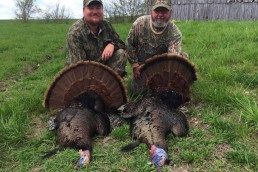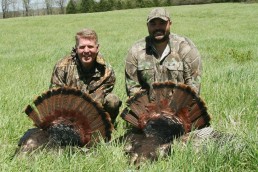Looking for the Boss: Admire, or Take, the Dominant Gobbler
SHARE THIS POST
Picture this: A long-beard quickly approaches shotgun range strolling silently to your calls—he’s headed your way. Suddenly, a fan appears and another gobbler waltzes onto a small hill following two hens, but he’s about 75 yards away. What are you going to do? The first tom is now at 30 yards. Your safety is off. That bird is killable, right now.
Will you take him, or wait for the big boy on the hill?
Most hunters will take the bird that’s in range. After all, a bird in the hand—right? The closest gobbler is legal and pretty much in the bag. But in all likelihood, he’s a two-year-old and the strutter is the dominant bird. Do you fill your tag, or do you roll the dice on a trophy? It’s definitely a matter of preference, and either choice won’t get you kicked out of the club.
Know Mr. Big when you see him
Most turkey hunters would like to shoot the oldest or biggest gobbler on their hunting property. The trouble, though, is that it’s difficult to identify which gobbler is Mr. Big until you have him in hand. Fortunately, there are clues that help hunters identify the dominant bird.
The boss gobbler is normally the oldest (usually three years or older) and biggest bird on the property and it’s easier to identify him by the way he acts than what he looks like.
A dominant bird demonstrates dominant behavior.
Sometimes during early season, when gobblers are still in small groups, you can pick out the boss. He will be the one that displays the most. In some situations, the dominant tom will never come out of strut, keeping his head pulled back tight and his fan sticking straight up. He’ll also be the one chasing other toms, or you will see the others get out of his way as he approaches.
As the season progresses, the dominant birds will be alone with the hens. They’ll run all competitors away using brute force and big spurs.
Keep in mind that the boss might not have the longest or thickest beard, but he will be one that has long, sharp and sometimes hooked-up spurs. A two-year-old will have 1/2- to typically 7/8-inch spurs, but they tend to be rounded on the tips. A three-year-old turkey’s spurs will be one inch to 1 1/4 inches, start to curve, and are sharp. Any toms over three years old have long razor-sharp spurs and they really start to hook upward—these are limb-hangers.
While we’re on spurs: if a gobbler isn’t strutting, it’s possible to see them before taking a shot. In the right situation where there’s no tall grass or brush, hunters can make out the spurs when a gobbler gets within 30 yards. It’s easier for hunters in blinds who can get away with some movement and check them through binoculars.
Are you enjoying this post?
You can be among the first to get the latest info on where to go, what to use and how to use it!
Another way to identify the most mature tom out of a group is by the snood. When more than one excited, blood-red head comes within shotgun range, pick out the one with the longest snood hanging down past his beak. The longer it is, the more mature the gobbler will be.
What if there are no turkeys to be seen? How can you know a mature long-beard is around? Gobbling behavior can be a good indicator. The dominant bird is usually the one that gobbles first and early, alerting the hens to his whereabouts. This is not the rule though—another gobbler or multiple gobblers may sound off early. But if the boss is nearby and gobbles, they will quickly quiet down or fly down and go the opposite way, gobbling as they leave the area.
If you know there are turkeys in your hunting area but don’t hear a lot of gobbling, the odds are there’s a dominant tom close. Don’t give up if the toms are not hammering; they’re still there.
Life of a big boy
The dominant gobbler in your area has probably encountered many predators and hunters. This, coupled with his age, makes him difficult to bag. Old gobblers, by nature, are the most cautious animal in the spring woods. And by the same nature, they know the hens should come to them instead of vice versa.
It’s not impossible to get one within shotgun range, though. Here are a couple of tactics that will help your odds.
How to bag a big boy
He is old, he is wise, and he is vain—he’s the only gobbler around who has the right to breed. Use this to your advantage and decoy him into gun range. A full-strut, long-beard decoy placed among a couple of hen decoys will work, but this can also scare away a good three-year-old if he knows there is a bigger tom around.
The best choice for reeling in a tom is a quarter-strut jake, placed right behind a lay-down hen. Add a lookout or feeder hen decoy if you have them. This setup is deadly. A mature gobbler will not allow a jake to breed a hen in his domain.
A good calling trick is the retreating hen tactic. It is used when a gobbler is answering but will not come into range. It is easier with a hunting partner. One of the two hunters stays put and the other retreats, going in the opposite direction of the gobbler, calling subtly and occasionally along the way. This tactic can be employed without a partner, but the shooter has to play the role of the retreat caller and get back craftily to the site where the gobbler was answering the calls.
The ultimate challenge in the turkey woods is fooling the baron of the woods into range. If you find yourself trying to decide between the gobbler already in hand or waiting on another tom that’s just out of range—don’t fret, you win either way—you’re turkey hunting, and having a close encounter.
MWO
SHARE THIS POST
Did you enjoy this post?
You can be among the first to get the latest info on where to go, what to use and how to use it!
Andy Douglas
Andy Douglas is an avid hunter, outdoor writer, and photographer. He has been chasing whitetails, big toms, bass, and most game that can be had for over 35 years. He lives the outdoor lifestyle and is passionate about sharing with others through stories and photos. Email him at AndyDouglas.Outdoors@yahoo.com



